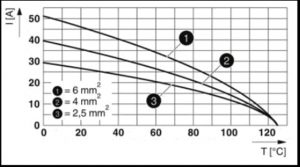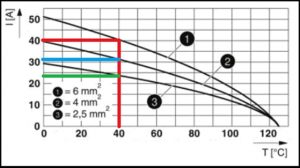Written by Scott Mulholland- Product Manager, Industrial Components
When deadlines are approaching, and the pressure is ramping up, we can all be guilty of specifying components that we are pretty sure will be fit for the job at hand. If time is of the essence, and the clock is ticking, it can be all too easy to give the product’s technical data a cursory ‘glance over’ for fleeting confirmation of what we suspect the product’s performance characteristics are.
Case in point:
“The supplier’s catalogue or website is showing a Rated Current of 40A for the product I am looking at. So I can safely use 35A for my application…can’t I ? ”
That depends!
- What cable size are you using?
- What is the ambient temperature of your application?
The maximum safe current for a connector is directly related to the cable size being used, and higher application temperatures can reduce the permitted maximum current!
“OK, but even with that information, how does it help me when the supplier is only showing “Rated Current = 40A”?!
That is where the de-rating curve comes into play. Below is a typical de-rating curve for our heavy duty HEAVYCON connectors. This curve is generated by testing the temperature increases of different current levels experienced by the connector according to standards DIN EN 61984 & DIN EN 60512-5-1.

The DIN standards require that test results are DE-rated, and 20% of the maximum current value is deducted before generating the published curves.
From this de-rating curve we then use 40°C as a nominal standard ambient temperature and identify what current rating is shown for 40°C and the maximum cable size. 6mm² is the maximum cable size = curve number. 1. So where curve number. 1 and 40°C connect = 40A (red line)

If you are using a smaller 4mm² cable (blue line) then the maximum safe current @ 40°C would be about 31A, and 2.5mm² (green line) = 24A.
So this example shows you how the cable size affects the maximum safe current that you can use, but the second important factor I mentioned earlier is the ambient temperature. Not every application experiences only 40°C!
The higher the ambient temperature, the lower the safe current rating.
The diagram below shows that an increase from 40 to 60°C would mean a drop from a 40A max current to a 34A max., and an ambient temperature of 80°C would reduce the safe current level down to 26A:

So, using the de-rating curve, the original question of – “The supplier’s catalogue or website is showing a Rated Current of 40A for the product I am looking at.
So “I can safely use 35A for my application… can’t I ?” can be now answered clearly:
– Yes, 35A is OK, if the cable size is 6mm² and the ambient temperature does not go above 55°C.
A summary of the above can be found in Phoenix Contact Catalogue technical data (see below).

So, in short, we may design and build a solution that works perfectly well on a wet Wednesday in Barnsley but fails miserably when shipped and commissioned in Qatar!
The de-rating diagrams really could save you time, money and above all, your company’s hard earned reputation!
For more information, contact Scott on smulholland@phoenxicontact.com or tel: 07908 583375

